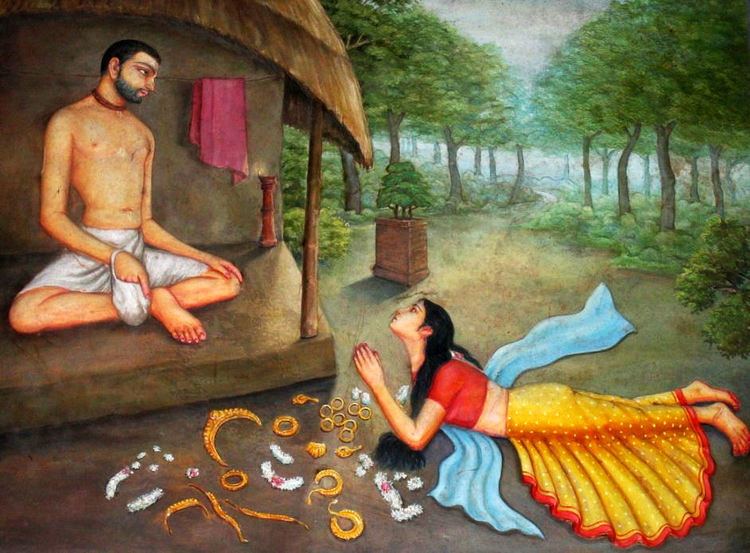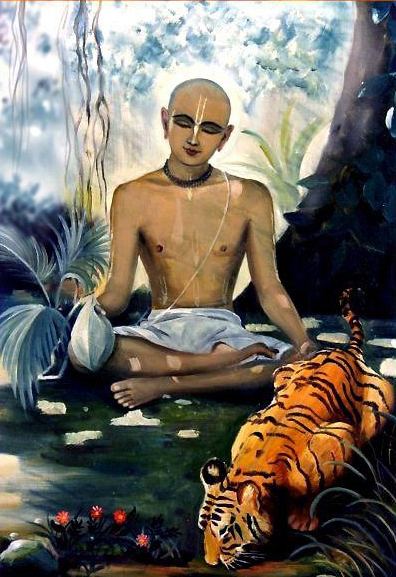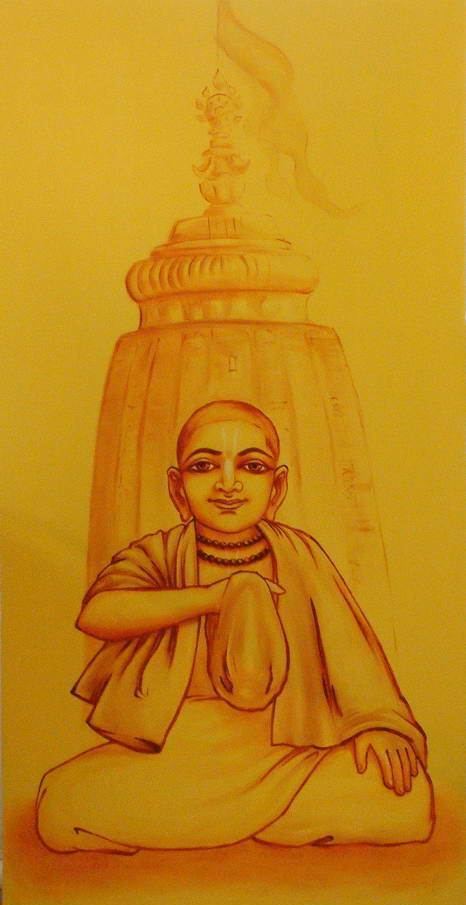Name Haridasa Thakur | Post Namacharya Ordination Vaishnava-Diksa | |
 | ||
Other names Mama thakur, Yavana Haridas, Predecessor Advaita Acharya and Chaitanya Mahaprabhu | ||
Illustrated story great personality srila haridasa thakura
Haridasa Thakur (IAST Haridāsa) (born 1451 or 1450) was a prominent Vaishnava saint known for being instrumental in the initial propagation of the Hare Krishna movement. He is considered to be the most famous convert of Chaitanya Mahaprabhu, apart from Rupa Goswami and Sanatana Goswami. His story of integrity and unflinching faith in the face of extreme adversity is told in Chaitanya Charitamrita, Antya lila. Besides being an ex-Muslim, he is famous because of his dedication to the religious practice of constantly chanting the names of God. Haridasa Thakura and Advaita Acharya,two senior and well-respected religious personalities of Gaudiya Vaishnavism in the local area of Mayapur, prayed for the descent of the yugavatara, (avatar of the era) believed to be Chaitanya. As an associate of Chaitanya Mahaprabhu, he is named the acharya, or guru, of the holy name. Due to his constant prayer and meditation on the names of God, he personified compassion, while being brutally beaten by Muslim aggressors he prayed incessantly that The Lord may forgive them. It is believed that Chaitanya Mahaprabhu himself designated Haridasa as nāmācarya, meaning the 'teacher of the Name'. Haridasa Thakura, was a devotee of God, Krishna, and had practiced chanting the names of the Lord, Hare Krishna, 300,000 times daily.
Contents
- Illustrated story great personality srila haridasa thakura
- Illustrated Story The glorious Departure of Srila Haridasa Thakura
- Background
- Early life
- Teachings
- Preaching of Hare Krishna chanting
- Other associates of Chaitanya called Haridas
- Identity
- Last years
- Death Disappearance
- Books
- Further information
- References

Illustrated Story - The glorious Departure of Srila Haridasa Thakura
Background
From the very beginning of Chaitanya's 16th century bhakti movement in Bengal, Haridasa Thakur and other born Muslims as well as those of various faiths joined together to spread love of God. This openness received a boost from Bhaktivinoda Thakura's broad-minded vision in the late 19th century and was institutionalized by Bhaktisiddhanta Sarasvati in his Gaudiya Matha in the 20th century. A disciple of Bhaktisiddhanta, Srila A. C. Bhaktivedanta Swami Prabhupada, is the founder of the International Society for Krishna Consciousness, that celebrates festivals memory of Haridasa Thakura in India and worldwide.

However one of the early records of the period by Isana Nagara, (c. 1564), author of the Advaita-prakasa, describes contemporary condition of the Hindus under 'Ala-ud-din Hussain Shah (1493–1519):

The wicked mlecchas pollute the religion of the Hindus every day. They break the images of the gods into pieces and throw away the articles of worship. They throw into fire Bhagavata Purana and other holy scriptures. They forcibly take away a conch shell and bell of the brahmanas, and lick the sandal paints of their bodies. They urinate like dogs on the sacred Tulasi plant and deliberately pass feces in the Hindu temples. They would throw water from their mouths on the Hindus engaged in worship, and harass the Hindu saints as if they were so many lunatics let large.
Early life
Born in the village of Buron (Budana), in the present district of Sat-kira, which was previously a sub-division of Khulna, now in Bangladesh. Haridasa was 35 years older than Chaitanya Mahaprabhu and his prayers along with prayers of Advaita Acharya were the reason for Chaitanya Mahaprabhu descent. Ishana Nagara in his book Advaita Prakasha, explains in great length that Haridasa Thakur was a follower of Advaita Acharya and also his close friend, he was raised in a Muslim family and then converted to Vaishnavism as a young man. Advaita Acharya repeatedly proclaims that becoming a Vaishnava, regardless of one's background, removes all past conditioning.
When Haridasa Thakura was a young devotee of the Lord, he was allured by the incarnation of Maya-devi, but Haridasa easily passed the test because of his unalloyed devotion to Lord Krsna. He also believed to have stayed and chanted in a cave with a notorious snake, however, seemed unaffected by all of this. He did not even seem to be aware of the snake's presence.
Haridasa first became associated with Advaita Acarya. Haricarana Dasa, the biographer of Advaita Acharya says that all the demigods in heaven heard prayers of Advaita and reveal themselves to him, therefore when Advaita saw Haridasa, he could immediately recognizes that he was Brahma incarnate and named him Hari-dasa (literary meaning servant of God). He instructs Haridasa to recite Krishna's names and assures him that Krishna will always show mercy to Haridasa. The close relationship between the two and the fact that Advaita was feeding a Muslim, became a subject of malicious gossip. This apparent anomaly create a stir in a brahmana community, where others could not understand how a powerful ascetic was disregarding a convention of keeping a distance from Muslims. The fact that community was disturbed is reflected in both Chaitanya Charitamrita and in Chaitanya Bhagavata. Haricarana Dasa in his historical records, confirms that while Advaita was from the higher ranks of Bengali brahmana community, he completely ignored the facts about Haridasa's background, being impressed with the young man's heartfelt devotion. While others became upset with Advaitas attention to Haridasa, and threatened to excommunicate Advaita, Advaita tells Haridasa to pay no attention to 'those petty people' and Advaita schedules a fire ceremony, agnihotra for the morning, and when preparations for this ritual to begin, there is no fire to be found in the whole town, and because of this whole life of the village is at a standstill. Advaita points out to all local brahmana priests that if priests are true to their religious teachings, there must be fire, and tells them to approach Haridasa with dried grass in their hands. When Haridasa relights all the fires with his potency, he also according to this record, manifests his four-faced Brahma-like form. While Agni, deity of Vedas responsible for fire is under control of the brahmanas, its Muslim born Haridasa, who lights the fires lost by all brahmanas in the village by the power of his devotion, 'the purity those born brahmana have lost.
Teachings
According to the philosophy of the holy name given by Haridasa Thakura, if you are on the platform of namabhasa (early or reflective stage of the pure chanting), it gives the chanter liberation, moksa. Whereas pure chanting gives prema, or 'Love of God'.
An episode from Chaitanya Charitamrita illustrates different side of the life of Haridasa Thakura, and does not allude to the trial of the Haridasa by the Muslim ruler, but gives details of a sakta brahmana, who would hire a harlot to try (unsuccessfully) to seduce the celibate saint. In this story the avenging instruments of divine justice are none other than the agents of the Muslim king, who eventually punishes Ramachandra Khan.(CC Antya. 3.98-163)
Haridasa Thakur was chanting mantra consisting of the names Hare, Krishna and Rama. Hare Krishna mantra appears originally in the Kali-Saṇṭāraṇa Upaniṣad:
It is often referred to as the "Maha Mantra" (great mantra) by practitioners.
Following the footsteps of Haridasa Thakur in 1966, A.C. Bhaktivedanta Swami Prabhupada established ISKCON (the International Society for Krishna Consciousness), a branch of the Brahma-Madhva-Gaudiya Vaishnava sampradaya, and introduced the Hare Krishna mantra to the West, described as: "an easy yet sublime way of liberation in the Age of Kali."
Preaching of Hare Krishna chanting
He was asked to join forces with Nityananda who was older than Chaitanya by some eight years, and he believed to infuse into the movement a great passion. Haridasa and Nityananda are famed for conversion of two notorious scoundrels, Jagai and Madhai, of Navadvipa into the new faith. They are considered important lieutenants in the campaign for spreading the sankirtana movement, chanting of the holy names: Brahma, in the form of Haridasa Thakura, and later, Balarama as Nityananda.
Other associates of Chaitanya called Haridas
Different associates of Chaitanya with this name include:
1. Haridasa Pandita (also known as Sri Raghu Gopala and as Sri Rasa-manjari), a disciple of Sri Ananta Acaryam. He is according to Tarapada Mukherjee is of a later generation. The fact that he is mentioned in the verses derived from Chaitanya Charitamrita, Adi 8 as a listener rather than participants in lila distinguishes them from contemporaries like that of Rupa and the others mentioned who were direct associates of Chaitanya. However according to Krishnadasa Kaviraja, the book which was read in the meetings of the first generation of Chaitanya followers in Vrindavan was the Bhagavata Purana itself and not Chaitanya's life story.2. Haridas (Junior), who accompanied Chaitanya on the journey to South India. It is believed that Chaitanya forsook the company of Junior Haridas because of an incident, that was against strict principles of a detached saint.Identity
"Chief Saktyavesa Avatara" {"youtu. be/ELOe3f-hihc My Sweet Lord" 3:58 Guru Brahma, Guru Vishnu, Gurudeva (Swamiji Srila Prabhupada).} Brahma is the only begotten son mentioned in the Bible. Christ & Haridas Thakur are expansions of Brahma. Brahma was born from a lotus flower emanating from the naval of Vishnu.
Haridasa Thakur in Gaudiya Vaishnavism is believed to be a combined incarnation of Brahma Mahatapa, the son of Richika Muni and Prahlada. The respected Murari Gupta has written in his Chaitanya Charitamrita that this sage’s son picked a tulasi leaf and offered it to Krishna without having washed it first. His father then cursed him to become a mleccha in his next life. He was thus born as Haridasa, a great devotee. (Gaura-ganoddesha-dipika 93-95)
Nabadwip-dhama-mahatmya by Bhaktivinoda Thakur has written the following account of how Brahma became Haridasa Thakur:
In Dvapara Yuga, Nandanandana Sri Krishna was herding the cows through Vraja Dham in the company of his cowherd boyfriends when Brahma decided to test the Lord out of a desire to see his majestic form and opulences. He stole both Krishna's cows and calves, as well as his friends and hid them for a year in the caves of Sumeru Mountain. But a year later, when Brahma returned to Vraja, he was astonished to see that Krishna was still there with both his friends and cattle. Brahma immediately understood his error and began to regret his rash action. He fell down at Krishna's feet and begged him for forgiveness; Krishna responded by mercifully revealing his divine opulence. He who appears in the Dvapara Yuga as Nandanandana Sri Krishna, descends again in the Kali Yuga as Gauranga, taking on the mood and bodily luster of Radharani in order to display the most magnanimous pastimes. Brahma was afraid that he might commit the same offense during Gaura's incarnation so he went to Antardvipa, the central island of Nabadwip, and began to meditate. The Lord was able to understand his mind and so came to him in the form of Gauranga and said, "During my incarnation as Gaura, you will be born in a family of mlecchas and will preach the glories of the Holy Name and bring auspiciousness to all the living beings
From the above it is understood that he was an incarnation of the secondary creator Brahma. It is said that in order to overcome his pride, he asked for a birth in a lowly family. Similar description is found in Advaita-vilasa.
Last years
Last years Haridasa has spent in Jagannatha Puri as a close associate of Chaitanya Mahaprabhu. One time Caitanya Mahaprabhu took Haridasa Thakura within the flower garden, and in a very secluded place He showed him his residence. He asked Haridasa to remain there and chant the Hare Krishna mantra, and said that He would personally come there to meet him every day. “Remain here peacefully and look at the cakra on top of the temple and offer obeisances. As for as your prasadam is concerned, I shall arrange to have it sent here”. Although Haridasa was not allowed to visit the temple because of the custom, Chaitanya promised to come and see him daily. To the belief of Gaudiya Vaishnavas this indicates that Haridasa Thakura was so advanced in spiritual life that although he was considered unfit to enter the temple of Jagannatha, he’s being personally visited by the lord every day. Prabhupada however on a number of occasions states that one should not imitate the behavior of Haridasa Thakura. He says the spiritual master gives different orders to different disciples:
Death (Disappearance)
He reasons ill who tells that Vaishnavas die
When thou art living still in Sound!
The Vaishnavas die to live & living try
To spread the holy name around!
Verse by Bhaktivinoda Thakura on the tomb of Haridasa Thakura at Puri, India, published in Swami Prabhupada's Narada Bhakti Sutra, (3.50, purport).
It is believed that Haridasa was buried on the ocean shore by Caitanya himself. Dr. A. N. Chatterjee makes a point in his doctoral thesis entitled "Chaitanya's impact on medieval Indian society" that death of Haridasa Thakura is one of the most important incidents which deserve mention when dealing with the last few years of Caitanya Mahaprabhus life. Haridasa dies after most of other Gaudiya Vaishnavas depart home from Puri, he collapses one day while singing Krishnas name. He is then placing a foot of Chaitanya Mahaprabhu on his chest and dies crying out "Sri Krishna Chaitanya".
Even when mahatmas, great souls, do appear in human society, they are often not appreciated or understood. Illustrating Gaudiya Vaishnava perspective on it Prabhupada writes:
Sometimes devotees are personally attacked with violence. Lord Jesus Christ was crucified, Haridasa Thakura was caned in twenty-two marketplaces, and Lord Caitanya's principal assistant, Nityananda, was violently attacked by Jagai and Madhai.... Although a sadhu is not inimical toward anyone, the world is so ungrateful that even a sadhu has many enemies.
However if one gets the association of a such mahatma and is receptive to his blessings, it is believed that one will infallibly be benefited.
Books
Chaudhuri, J. (1960). Mahaprabhu-Haridasam: The Mahaprabhu-Haridasam; a new Sanskrit drama on the life of Haridasa, one of the greatest devotees of Sri Krishna Chaitanya Mahaprabhu of Bengal.
Further information
For more details of his life story see Chaitanya Bhagavata In this text Haridasa's tribulations are given in detail.
